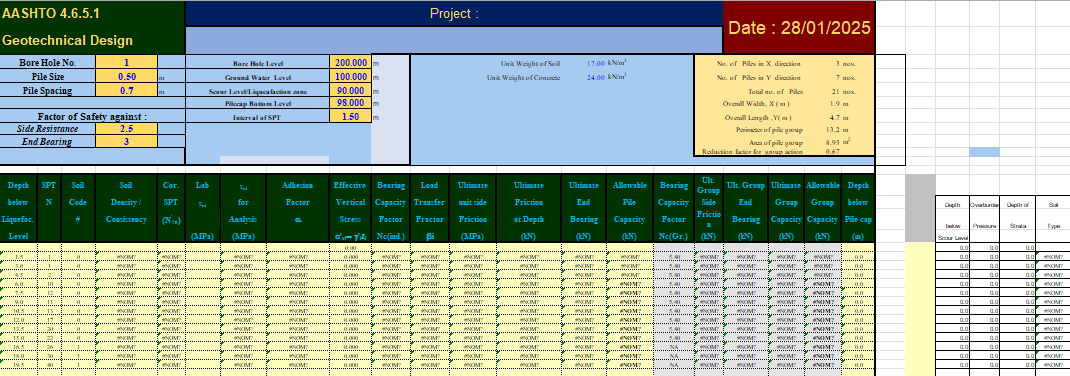
AASHTO GeoTechnical Design of Pile Spreadsheet
1 February 2025Table of Contents
AASHTO GeoTechnical Design of Pile Spreadsheet
Pile foundations are critical components in infrastructure projects, providing the necessary support for bridges, highways, and other load-bearing structures. The American Association of State Highway and Transportation Officials (AASHTO) provides comprehensive guidelines for determining pile capacity to ensure safety, stability, and long-term performance.
What is Pile Capacity?
Pile capacity refers to the ability of a pile to support applied loads without experiencing failure. It consists of two primary components:
- End Bearing Capacity: The resistance developed at the tip of the pile when it reaches a firm stratum.
- Skin Friction Capacity: The frictional resistance generated along the surface of the pile shaft due to interaction with the surrounding soil.
AASHTO provides specific methods to estimate both components, ensuring that engineers can design pile foundations with adequate load-bearing capacity.
AASHTO Guidelines for Pile Capacity Calculation
AASHTO recommends using both theoretical calculations and field tests to determine pile capacity. The following methods are commonly used:
1. Static Analysis Method
This method involves:
- End Bearing Capacity Calculation: Based on soil strength parameters such as standard penetration test (SPT) values, cone penetration test (CPT) data, and soil cohesion.
- Skin Friction Calculation: Determined by soil type, pile material, and pile length.
2. Dynamic Load Testing
Dynamic load testing, such as the High Strain Dynamic Testing (PDA test), evaluates pile resistance during hammer driving. It is commonly used for driven piles.
3. Static Load Testing
A direct and accurate method, static load testing involves applying loads to a test pile and measuring settlement, providing real-world verification of theoretical calculations.
4. Wave Equation Analysis
AASHTO recommends using wave equation analysis to predict the driving resistance and stresses on driven piles, helping engineers assess the pile behavior under dynamic conditions.
Factors Affecting Pile Capacity
Several factors influence pile capacity according to AASHTO:
- Soil Type: Cohesive and granular soils behave differently under load.
- Pile Material: Steel, concrete, and timber piles have varying strength and durability.
- Installation Method: Driven piles and bored piles develop different skin friction and end bearing properties.
- Groundwater Conditions: Water levels can affect soil strength and pile performance.
Ensuring Compliance with AASHTO Standards
To design piles in accordance with AASHTO, engineers must:
- Conduct thorough geotechnical investigations.
- Use appropriate load factors for safety and serviceability.
- Validate theoretical calculations with field testing.
- Consider long-term effects such as settlement and scour.
Download the Pile Capacity Calculation Spreadsheet
To simplify your pile design process, we’ve prepared a detailed Pile Capacity Calculation Spreadsheet based on AASHTO guidelines. This tool will help you quickly estimate pile bearing capacity with ease.
Download Here and streamline your geotechnical analysis today!


